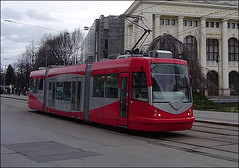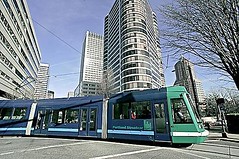Looking backwards vs. looking forwards, tradeoffs, constraints and urban revitalization in the 21st century city
In response to today's Post article, "D.C. streetcar project may get hung up on overhead wires" about the possibilities of implementing streetcars in DC versus restrictions on overhead wires in the "L'Enfant City", I offer the following. Although as rg says, it's a somewhat biased article, where opponents get the first and last word.

Just like T. Boone Pickens wants to convert cars from gasoline to natural gas to make money but to use "technology" as a solution to declining oil supplies but without changing wasteful and uneconomic transportation and land use paradigms, people in the city who are against streetcars aren't against the streetcar per se, but are against overhead wires, and advocate for a technological solution--underground wires--which at the present time doesn't exist in a practical way.
Yes, there is some limited use of underground powering in Bordeaux, but it doesn't work for very long distances, less than one mile it works very well. And battery power doesn't last for long distances either, right now less than a couple miles. Now, ultracapicitors could do quick recharging, but I will leave that to the physicists to explain. And Bombardier is testing an underground powering system, but it doesn't exist yet.
There are a couple issues with the opposition to streetcars, and I have written before that it comes down to the difference between thinking about the future of the city in a time when trends favor urban living and the city can add population vs. the time when trends didn't favor urban living, the city was shrinking, and the main priority of activists, especially historic preservation activists, was stabilizing neighborhoods within a declining city.
These activists were very successful. Many of the city's neighborhoods were saved, and it is unfortunate that many of the benefits of their hard work are now reaped by people who have no appreciation for the difficult struggle endured by the preservationists, who these days are often derided for their positions, and who have been for the most part, disenfranchised by the political elites--few people on City Council nor the Mayor nor the Deputy Mayor or City Administrator are committed to historic preservation, even though for the most part it saved the city.
What my criticism has been of what we might call "legacy preservationists" is that they are backwards looking, focused on maintaining a shrinking city, when the city has the opportunity to grow.
At the same time, they are still very much (for the most part) committed to an automobile-centric mobility paradigm, even though most of the city was designed at a time when cars did not exist and so the spatial form of the city was designed to optimize walking, and in turn the urban design favored bicycling and transit.
They would deny that they are pro-car but it is hard to argue differently, in terms of the reality of their position on the ground.
The future of the city is in limiting automobile traffic, including parking(!!) and prioritizing and constantly improving and extending transit.
That's where streetcars come in.

DC streetcar in Ostrava. DDOT photo.
I am not trying to belittle the concern over overhead wires and impacting the viewshed.
But the reality is that the viewshed won't be negatively impacted in a significant way, because the wires aren't easily seen, especially from long distances. Plus, automobile traffic is a significantly negative impact on the environment also.

MARK HARRISON / THE SEATTLE TIMES. Portland's streetcar runs through downtown, from Nob Hill to the Willamette River at RiverPlace, on a loop of track that shares the street with cars and people

Flickr photo of the Girard line SEPTA streetcar on Schuylkill river bridge by LHOON.
Don't think that I think that DC's streetcar planning is super-great. It's not. I think it's very parochial and limited, focused on "serving residents" without focusing on how streetcars and other surface based fixed rail transit (light rail) can interdict (reduce) regional traffic ino the city on major regionally-serving arterials such as Rhode Island Avenue, Georgia Avenue, Connecticut Avenue, and Wisconsin Avenue.
Instead, the services are crippled, and the alignments that are now being offered allow for limited inter-regional traffic reduction, which I think is a benefit to residents, were it to occur.
For example, a north serving route shouldn't be ending at Takoma, even though such a line is great for me personally, and will likely lead to an increase the value of my house, instead it ought to go to Silver Spring, along Georgia Avenue thereby improving the quality of service on one of the city's highest in demand bus routes, and through the service improvements, providing more reasons for people to not to drive in the city.

SOURCE: DDOT Nathaniel Vaughn Kelso/The Washington Post - April 6, 2010
In any case, I don't think that this dilemma is going to be resolved anytime soon.
For years, I have offered a "solution."
DC people are very much change-averse. (Witness the debacle over putting a streetcar in Anacostia. It's happening, but Council's desires to promote transit there and equity was almost trumped by fears of change there as well.)
Rather than worry about changing the law and getting Congress and the National Park Service and the National Capital Planning Commission on board now:
• JUST BUILD A DEMONSTRATON LINE
• IN A HIGHLY VISIBLE PLACE
• WHERE IT WILL EXPERIENCE HIGH RIDERSHIP AND SUCCESS
• IN A PLACE WHERE THE LEGAL RESTRICTION ON OVERHEAD WIRES DOESN'T PERTAIN.
To me, that's the line between Woodley Park and Brookland, although this line, which I call the University Line, should be extended at both ends.
(During the original DC Alternatives Analysis process I suggested a Rhode Island line that could go deep into Prince George's, and that the Crosstown line, instead of terminating at Brookland, could go up Michigan Avenue, Queens Chapel Road, and Adelphi Road to the University of Maryland. See this blog entry, "Will streetcars really return to the Capital City" for a discussion of the "University Line" proposal, and this one, "A different opinion on BRT," for a mention of the Rhode Island proposal.)
In a fast tracked project, it can take 5-10 years for a transportation project to be realized.
And that's without the opposition of grandstanding Congresspeople, lifelong federal government bureaucrats, and hard core but aging zealots who are fighting streetcars perhaps as their last hurrah.
So many legal and political changes have to occur to get the streetcars in place in the L'Enfant City that instead I would go for what the military calls an asymmetric strategy.
Let people see the streetcar work. Let people see the success. Then they will be demanding streetcar expansion and service to their own neighborhoods.
Until then people are going to be arguing with no resolution. And the change averse groups will have the upper hand.
From Wikipedia:
Asymmetric warfare is war between belligerents whose relative military power differs significantly, or whose strategy or tactics differ significantly.
"Asymmetric warfare" can describe a conflict in which the resources of two belligerents differ in essence and in the struggle, interact and attempt to exploit each other's characteristic weaknesses. Such struggles often involve strategies and tactics of unconventional warfare, the "weaker" combatants attempting to use strategy to offset deficiencies in quantity or quality.[1] Such strategies may not necessarily be militarized.[2] This is in contrast to symmetric warfare, where two powers have similar military power and resources and rely on tactics that are similar overall, differing only in details and execution.
Labels: change-innovation-transformation, civic engagement, progressive urban political agenda, sustainable land use and resource planning, transportation planning, urban design/placemaking



0 Comments:
Post a Comment
<< Home